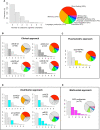Comparing different approaches for operationalizing subjective cognitive decline: impact on syndromic and biomarker profiles
- PMID: 33623075
- PMCID: PMC7902653
- DOI: 10.1038/s41598-021-83428-1
Comparing different approaches for operationalizing subjective cognitive decline: impact on syndromic and biomarker profiles
Abstract
Subjective cognitive decline (SCD) has been proposed as a risk factor for future cognitive decline and dementia. Given the heterogeneity of SCD and the lack of consensus about how to classify this condition, different operationalization approaches still need to be compared. In this study, we used the same sample of individuals to compare different SCD operationalization approaches. We included 399 cognitively healthy individuals from a community-based cohort. SCD was assessed through nine questions about memory and non-memory subjective complaints. We applied four approaches to operationalize SCD: two hypothesis-driven approaches and two data-driven approaches. We characterized the resulting groups from each operationalization approach using multivariate methods on comprehensive demographic, clinical, cognitive, and neuroimaging data. We identified two main phenotypes: an amnestic phenotype characterized by an Alzheimer's Disease (AD) signature pattern of brain atrophy; and an anomic phenotype, which was mainly related to cerebrovascular pathology. Furthermore, language complaints other than naming helped to identify a subgroup with subclinical cognitive impairment and difficulties in activities of daily living. This subgroup also showed an AD signature pattern of atrophy. The identification of SCD phenotypes, characterized by different syndromic and biomarker profiles, varies depending on the operationalization approach used. In this study we discuss how these findings may be used in clinical practice and research.
Conflict of interest statement
The authors declare no competing interests.
Figures





Similar articles
-
Subjective Cognitive Decline Below and Above the Age of 60: A Multivariate Study on Neuroimaging, Cognitive, Clinical, and Demographic Measures.J Alzheimers Dis. 2019;68(1):295-309. doi: 10.3233/JAD-180720. J Alzheimers Dis. 2019. PMID: 30741680
-
Cross-sectional and longitudinal characterization of SCD patients recruited from the community versus from a memory clinic: subjective cognitive decline, psychoaffective factors, cognitive performances, and atrophy progression over time.Alzheimers Res Ther. 2019 Jul 8;11(1):61. doi: 10.1186/s13195-019-0514-z. Alzheimers Res Ther. 2019. PMID: 31286994 Free PMC article.
-
Reduced Lexical Access to Verbs in Individuals With Subjective Cognitive Decline.Am J Alzheimers Dis Other Demen. 2019 Feb;34(1):5-15. doi: 10.1177/1533317518790541. Epub 2018 Jul 24. Am J Alzheimers Dis Other Demen. 2019. PMID: 30041538 Free PMC article.
-
Subjective Cognitive Decline in Preclinical Alzheimer's Disease.Annu Rev Clin Psychol. 2017 May 8;13:369-396. doi: 10.1146/annurev-clinpsy-032816-045136. Annu Rev Clin Psychol. 2017. PMID: 28482688 Review.
-
Subjective cognitive decline: preclinical manifestation of Alzheimer's disease.Neurol Sci. 2019 Jan;40(1):41-49. doi: 10.1007/s10072-018-3620-y. Epub 2018 Nov 5. Neurol Sci. 2019. PMID: 30397816 Review.
Cited by
-
Subjective cognitive and olfactory impairments predict different prospective dementia outcomes.Chem Senses. 2024 Jan 1;49:bjae033. doi: 10.1093/chemse/bjae033. Chem Senses. 2024. PMID: 39298281 Free PMC article.
-
Multimorbidity Patterns in US Adults with Subjective Cognitive Decline and Their Relationship with Functional Difficulties.J Aging Health. 2022 Oct;34(6-8):929-938. doi: 10.1177/08982643221080287. Epub 2022 Mar 24. J Aging Health. 2022. PMID: 35331040 Free PMC article.
-
Examining the role of participant and study partner report in widely-used classification approaches of mild cognitive impairment in demographically-diverse community dwelling individuals: results from the Einstein aging study.Front Aging Neurosci. 2023 Nov 21;15:1221768. doi: 10.3389/fnagi.2023.1221768. eCollection 2023. Front Aging Neurosci. 2023. PMID: 38076542 Free PMC article.
-
The Association Between Temporal Atrophy and Episodic Memory Is Moderated by Education in a Multi-Center Memory Clinic Sample.J Alzheimers Dis. 2023;92(2):605-614. doi: 10.3233/JAD-220741. J Alzheimers Dis. 2023. PMID: 36776050 Free PMC article.
-
The discriminant validity of single-question assessments of subjective cognitive complaints in an Asian older adult population.Front Aging Neurosci. 2022 Aug 8;14:901592. doi: 10.3389/fnagi.2022.901592. eCollection 2022. Front Aging Neurosci. 2022. PMID: 36004002 Free PMC article.
References
Publication types
MeSH terms
LinkOut - more resources
Full Text Sources
Other Literature Sources
Medical

